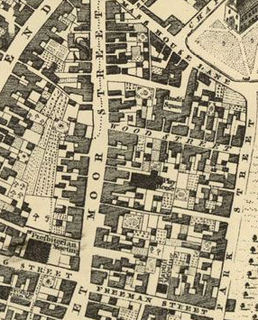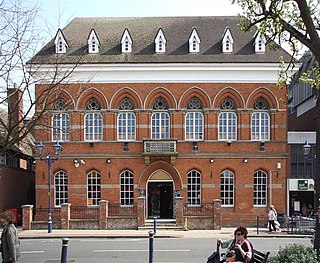Related Research Articles

Tamworth is a market town and borough in Staffordshire, England, 14 miles (23 km) north-east of Birmingham and on the West Coast Main Line. The town borders North Warwickshire to the east and north, Lichfield to the north, south-west and west. The M6 Toll runs to the south of the town. It takes its name from the River Tame, which flows through it. The population of Tamworth borough (mid-2019 est.) was 76,696. The wider urban area has a population of 81,964.

Royal Leamington Spa, commonly known as Leamington Spa or simply Leamington, is a spa town and civil parish in Warwickshire, England. Originally a small village called Leamington Priors, it grew into a spa town in the 18th century following the popularisation of its water which was reputed to have medicinal qualities. In the 19th century, the town experienced one of the most rapid expansions in England. It is named after the River Leam, which flows through the town.

Birmingham has seen 1400 years of growth and during which time it has evolved from a small 7th century Anglo Saxon hamlet on the edge of the Forest of Arden at the fringe of early Mercia to become a major city. A combination of immigration, innovation and civic pride helped to bring about major social and economic reforms and to create the Industrial Revolution, inspiring the growth of similar cities across the world.

William Caslon I, also known as William Caslon the Elder, was an English typefounder. The distinction and legibility of his type secured him the patronage of the leading printers of the day in England and on the continent. His typefaces transformed English type design and first established an English national typographic style.

Pebble Mill Studios was the BBC's television studio complex located in Edgbaston, Birmingham, England, United Kingdom, which served as the headquarters for BBC Birmingham from 1971 until 2004. The nine-acre site was opened by Princess Anne on 10 June 1971, and in addition to the studios contained two canteens, a post office, gardens, a seven-storey office block, and an outside broadcasting (OB) base.

The culture of Birmingham is characterised by a deep-seated tradition of individualism and experimentation, and the unusually fragmented but innovative culture that results has been widely remarked upon by commentators. Writing in 1969, the New York-based urbanist Jane Jacobs cast Birmingham as one of the world's great examples of urban creativity: surveying its history from the 16th to the 20th centuries she described it as a "great, confused laboratory of ideas", noting how its chaotic structure as a "muddle of oddments" meant that it "grew through constant diversification". The historian G. M. Young – in a classic comparison later expanded upon by Asa Briggs – contrasted the "experimental, adventurous, diverse" culture of Birmingham with the "solid, uniform, pacific" culture of the outwardly similar city of Manchester. The American economist Edward Gleason wrote in 2011 that "cities, the dense agglomerations that dot the globe, have been engines of innovation since Plato and Socrates bickered in an Athenian marketplace. The streets of Florence gave us the Renaissance and the streets of Birmingham gave us the Industrial Revolution", concluding: "wandering these cities ... is to study nothing less than human progress."

The Bath Assembly Rooms, designed by John Wood the Younger in 1769, are a set of assembly rooms located in the heart of the World Heritage City of Bath in England which are now open to the public as a visitor attraction. They are designated as a Grade I listed building.
The Camp Hill line is a railway line in Birmingham which lies between Kings Norton on the Cross-City Line and Birmingham New Street via Grand Junction on the main lines from Derby and Coventry.

Birmingham is a major city and metropolitan borough in the West Midlands, England. It is the UK’s largest and most populated metropolitan borough, standing as the ‘Core City’ within the second-largest metropolitan area and third-largest urban area in the United Kingdom, with roughly 1.2 million inhabitants within the borough (city-proper) area, 2.8 million inhabitants within the urban area and 4.3 million inhabitants within the larger metropolitan area. Birmingham is commonly referred to as the "second city of the United Kingdom".

The Birmingham Gazette, known for much of its existence as Aris's Birmingham Gazette, was a newspaper that was published and circulated in Birmingham, England, from the eighteenth to the twentieth centuries. Founded as a weekly publication in 1741, it moved to daily production in 1862, and was absorbed by the Birmingham Post in 1956.

The Moor Street Theatre was the first regular theatre – as distinct from earlier booths and converted barns for strolling players – to be established in Birmingham, England. Located in a back yard between Moor Street and Park Street north of the Bull Ring, it opened in 1740 with a performance of "Oratorio with Vocal and Instrumental Musick".
Essex Street Chapel, also known as Essex Church, is a Unitarian place of worship in London. It was the first church in England set up with this doctrine, and was established when Dissenters still faced legal threat. As the birthplace of British Unitarianism, Essex Street has particularly been associated with social reformers and theologians. The congregation moved west in the 19th century, allowing the building to be turned into the headquarters for the British and Foreign Unitarian Association and the Sunday School Association. These evolved into the General Assembly of Unitarian and Free Christian Churches, the umbrella organisation for British Unitarianism, which is still based on the same site, in an office building called Essex Hall. This article deals with the buildings, the history, and the current church, based in Kensington.
The Warwickshire Company of Comedians, also known as Mr Ward's Company of Comedians and after 1767 as Mr Kemble's Company of Comedians, was a theatre company established by John Ward in Birmingham, England in the 1740s, touring throughout the West Midlands region and surrounding counties over subsequent decades. Unusual in the 18th century as a provincial company producing performances to London tastes and standards, it is particularly notable as the origin of the Kemble family theatrical dynasty, which was to dominate the English stage in the late-18th and early 19th centuries. Sarah Siddons and John Philip Kemble in particular, who were Ward's grandchildren and whose careers began in the company, were the leading actress and actor of their time, and are still considered among the greatest performers in English theatrical history.

The literary tradition of Birmingham originally grew out of the culture of religious puritanism that developed in the town in the 16th and 17th centuries. Birmingham's location away from established centres of power, its dynamic merchant-based economy and its weak aristocracy gave it a reputation as a place where loyalty to the established power structures of church and feudal state were weak, and saw it emerge as a haven for free-thinkers and radicals, encouraging the birth of a vibrant culture of writing, printing and publishing.
The Birmingham Musical and Amicable Society was a musical society formed by James Kempson and Michael Broome in 1762 in Birmingham, England. Most of its members were drawn from the choirs of St Philip's Church and St. Bartholemew's Chapel, who had met at Cooke's Coffee Shop in the Cherry Orchard in Birmingham since the 1730s.

The Royal Hotel, originally just The Hotel, was a hotel located on Temple Row in Birmingham, England. Opened in 1772, it was the first establishment in Birmingham to describe itself as a "hotel", a new term entering usage around this time to denote a more fashionable and genteel establishment than the more traditional inn.
The King Street Theatre was the first purpose-built theatre to open in Birmingham, England. The town had had earlier theatres, but the Theatre in Smallbrook Street, whose origins dated back to 1715, and Theatre in New Street, which was in an existence a few years later, were both makeshift structures; and the more substantial Moor Street Theatre, which opened in 1740, was a conversion of an existing building. King Street was a much more ambitious undertaking, being based on the examples of the established London patent theatres.

Birmingham is an important centre for theatre in the United Kingdom. The earliest known performances in the city were medieval pageants and miracle plays. Birmingham's first permanent theatres and theatrical companies were founded in the 1740s, drawing both actors and performance styles from the fashionable theatres of London. During World War II, the Birmingham Blitz forced all performance venues in the city to close; most would stay closed throughout the war. The postwar introduction of television led to further theatre closures.

The Old Council House is a former municipal building in Poplar Road, Solihull, West Midlands, England. The town hall, which was the meeting place of Solihull Borough Council, is now a public house.
References
- 1 2 Money, John (1977), Experience and identity: Birmingham and the West Midlands, 1760-1800, Manchester University Press, p. 83, ISBN 0719006724 , retrieved 24 February 2013
- 1 2 3 Hill, Joseph; Dent, Robert K. (1897), Memorials of the Old Square, Birmingham: Achilles Taylor, pp. 84–85, OCLC 8263180
- 1 2 3 Pendleton, Muriel (2010), From bullbaiting to theater and oratorio attending: The cultural development of Birmingham during the eighteenth century, Long Beach, CA: California State University, pp. 27–28, retrieved 24 February 2013
- ↑ Stephens, W. B. (1964), "Social History before 1815", in Stephens, W.B. (ed.), The City of Birmingham, The Victoria History Of The County Of Warwick, vol. VII, Oxford: Oxford University Press, pp. 209–222, retrieved 24 February 2013